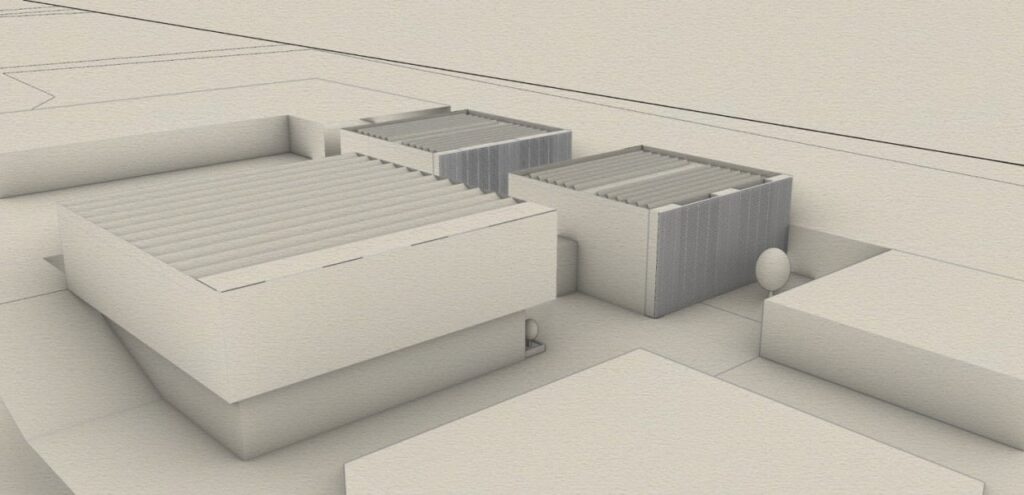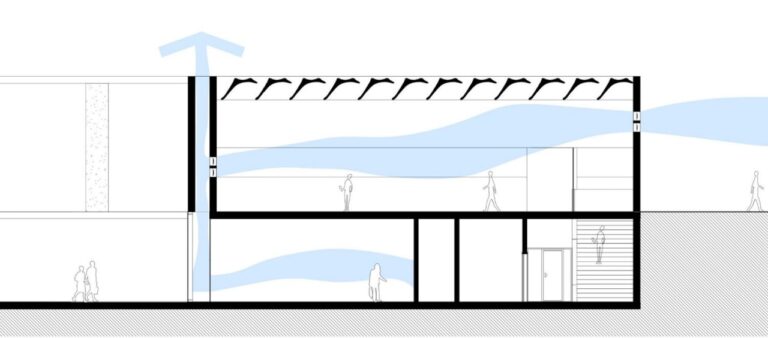Investigation and selection of ventilation strategies (Part1)
Case studies: double-skin facade and solar chimney

Abstract
Today, more than 40% of global energy consumption is related to the building industry. Also, with the increasing urbanization, the need to reduce energy consumption in the building sector is felt more than ever. Many researchers have done extensive research on these topics. One of the mentioned fields is the application of various active and passive strategies in the design of buildings. However, because this field of research is climate-oriented, examining different approaches in different states and conditions in different climates can help localize this knowledge.
In the present study, active and inactive strategies in the ventilation field of a cultural center in Kerman have been studied. This cultural center is also a minor part of a commercial-cultural and residential center.
In this research, first, concerning the leedv4.1 standard, different strategies have been examined. Then, according to the various references of this standard to various European and American standards, the final decision was made. As a result, by choosing a mixed strategy from natural ventilation and mechanical ventilation: 1- double-skin facades in different modes 2- Solar chimneys in other methods.
Finally, as a result, it can be noted that the use of a double-skin facade cannot be fruitful for this user. Also, using a particular type of solar chimney in the south front of the building can improve the natural ventilation rate.
1-1Choosing a building ventilation strategy
In this section, referring to the LEED V4.1 standard in the ventilation section, we examined different natural and mechanical ventilation methods.
In the mentioned standard, the first method was selected after discussion. In this method, it is stated that for more detailed discussion, refer to the Natural standard ventilation in non-domestic buildings CIBSE Applications Manual AM10. After referring to this standard And the relevant part of page 9 of photos 8-8, we act according to the visible diagram in front.
In the first step of this diagram, the amount of heat load is checked. This section states that it should be between 30 and 40 watts per square meter. After modeling Design Builder software, we conclude that this amount is less than 40 watts per sq meter in the current design. It will not be square. So, according to the steps specified in the image, we will proceed to reach the mixed ventilation strategy, which will be mentioned on the next page.

Picture 1: In this method, it is stated that for more detailed discussion, refer to the Natural standard ventilation in non-domestic buildings CIBSE Applications Manual AM10. After referring to this standard And the relevant part of page 9 of photos 8-8, we act according to the visible diagram in front.
1-2 Mixed- mode ventilation
Continuing the previous section, we go to a new standard that during the last quarter, after studying the proposed path, it became clear that a new standard should be referred to.
By referring to the Mixed mode ventilation standard CIBSE Applications Manual AM13: 2000, we find that initially, we have to follow the proposed path in the opposite figure. Whether we have reached the mix ventilation or not, according to the steps specified in the image, we find that we still need to reconsider the actions identified.
However, in general, it can be said that the right path to achieve this goal is underway.
Now we have to optimize the various topics in ventilation and go back to the opposite diagram during a round-trip process.

Picture 2: By referring to the Mixed mode ventilation standard CIBSE Applications Manual AM13: 2000, we initially have to follow the proposed path in the opposite figure.
2-Examine different strategies
2-1 double-skin facade
Architectural technology and building sciences have always sought to use methods to reduce energy consumption and increase environmental comfort. The outer shell of buildings has always been considered because of the direct connection with external conditions. In the exterior walls of the building, due to this direct connection with the exterior space, all major exchanges in terms of energy take place. Exchanges such as direct sunlight are wasted. Winter heat, unintentional ventilation, and
Today, one of the methods to deal with various phenomena of domestic occupants’ discomfort and simultaneously optimize energy consumption is to use a variety of double-skin or multi-skin facades. This method was first used in cold climates. Today, it has become one of the standard methods in temperate and warm climates. This method, especially in office buildings, is discussed by many researchers and energy activists.
This section will examine the double-skin facade in two models, the shaft and the corridor.
2-1-1 double-skin facade alternative no 1
In this section and the continuation of those other sections, we will examine two strategies. First is the double-skin facade. In this section, we will discuss two models of the double-skin facade, which this section is dedicated to shaft mode. In this case, the facade is divided into two shells, sections 50 cm deep, 2 m wide, and 10 m high.
In this section, it is expected that these spaces will act as chimneys and improve ventilation.
The simulation results of this section are shown in the next photo.
1-2 Mixed-mode ventilation
Continuing the previous section, we went to a new standard during the last quarter; after studying the proposed path, it became clear that a new standard should be referred to.
By referring to the Mixed mode ventilation standard CIBSE Applications Manual AM13: 2000, we initially have to follow the proposed path in the opposite figure. Whether we have reached the mix ventilation or not, according to the steps specified in the image, we still need to reconsider the actions identified.
However, in general, it can be said that the right path to achieve this goal is underway.
Now we have to optimize the various topics in ventilation and go back to the opposite diagram during a round-trip process.

picture 3: first alternative of double skin facade

picture 4: Diagram of the expected hypothetical flow in the double-skin facade and the gallery and library spaces air behind the windows is expected to overheat and move upwards, improving ventilation rates and passive cooling. As can be seen, the use of a double-skin facade has reduced energy consumption in general, but its primary purpose, which has been to use passive ventilation, has not been achieved. In the mentioned gallery space, the ventilation rate has been relatively better, but it has not reached the required level of 0.8 ACH(air change per hour). The library space has not been able to use natural ventilation. It can be concluded that the use of a double-skin facade in the current state does not help the desired issue in the field of ventilation.
